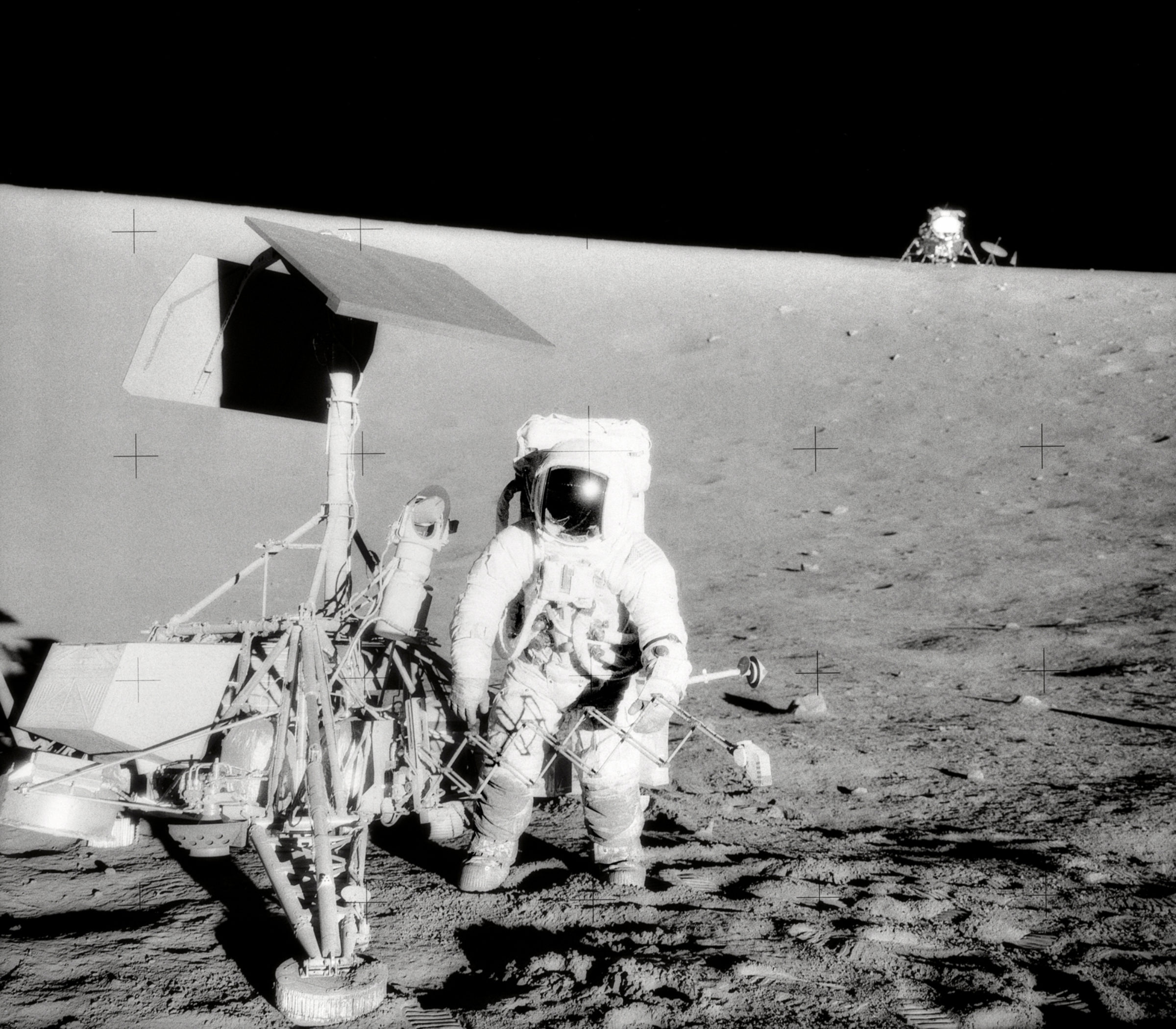Philip Metzger • Apr 21, 2014
Forensic Ballistics: How Apollo 12 Helped Solve the Skydiver Meteorite Mystery
The news went viral a couple of weeks ago. A team in Norway announced that a skydiver was almost struck by a meteorite in flight over the ØstreÆra airstrip near Rena, Norway. Their evidence was this video. The rock passes by at about 0:15:
Here is a composite picture of the falling rock:

The event was actually two years ago. In the time since then, a team assembled and performed an impressive amount of analysis to measure the rock falling in the video and to predict where it had fallen. If confirmed as a meteorite, this would be the first time one had ever been filmed during its “dark flight,” the portion of its trajectory after the fireball when it has gone cold and is falling essentially straight down at terminal velocity. (Terminal velocity is the constant speed a falling object attains when its drag force becomes the same as its weight.)
In the video, it was impossible to tell the distance of the rock from the camera, since a single camera lacks the stereoscopic distance-finding of two human eyes, and thus the team could not tell how large the rock was or how fast it was falling. It could have been a small rock up close to the camera, or a large rock far away. When they compared it to a typical meteorite falling at terminal velocity, it seemed most likely that it was 4.6 meters away from the skydiver, making it 12 by 16 centimeters in size, and an estimated 4.6 kilograms in mass. The shape, albedo, texture, and other details of the rock also reasonably agreed with common meteorites. However, after searching the small region of forest where it was known to have fallen – an area rather tightly constrained by the video analysis – no such meteorite was found. After two years of fruitless searching, the team decided to leverage the power of crowdsourcing to see if others could find something that had been overlooked and thus help solve the mystery. As it turned out, help came all the way from the Moon.

On November 19, 1969, the Apollo 12 Lunar Module landed on the Moon’s Mare Cognitum, 160 meters from the deactivated Surveyor 3 spacecraft, which had been collecting dust (literally) for two and a half years. Astronauts Pete Conrad and Alan Bean walked to Surveyor 3, cut off several parts including its camera, a cable harness, and two struts, and brought them back to Earth for analysis. These would tell the engineers how spacecraft materials degrade in the lunar environment: the harsh ultraviolet light, severe temperature swings, vacuum, cosmic radiation, micrometeoroid impacts, and dust. This would prove invaluable. But the astronauts also made a chilling discovery: during their landing, rocket exhaust from the Apollo Lunar Module's main engine blew dust, sand, and rocks at high velocity all around the area, and some of it impacted Surveyor 3.
This was a wakeup call for engineers. Human spaceflight planners would like to put a refueling station on Mars so rockets can land, fuel up, and lift off again. Studies show that making rocket propellants out of the ice and atmosphere of Mars could reduce the cost of missions tremendously. But as Apollo 12 showed, if we land and launch near the refueling station and excessively sandblast critical hardware in the process, we could render it inoperable. And if you can’t refuel your rocket, you can’t come home.
A few years ago my team obtained several of the returned pieces of Surveyor 3 from the Lunar Receiving Lab at the Johnson Space Center. We examined them with a Scanning Electron Microscope and other instruments that weren’t available when they were first brought back from the Moon in the 1970’s. We counted and measured every tiny pinhole that punctured the surface. At the bottoms of these holes, we found lunar sand particles that had been blown there by the Lunar Module's rocket exhaust.

We also observed the damage that dust particles did as they crushed and scoured the surface of the hardware at a microscopic level. This provided a quantitative measure of the sandblasting effects.

We obtained high-quality copies of the videos looking out the windows of the Lunar Modules during all six lunar landings and we measured in them the blowing dust and rocks using photogrammetric methods (similar to those used by the team in Norway investigating the skydiver’s rock). These data tell us how much soil is blown by a Lunar Module and into what trajectories. But to make predictions for other spacecraft, we needed a software model, so the team developed a code that predicts how dust, sand, and rocks are blown by rocket exhaust as it expands into a vacuum at extreme velocities. The software models were compared with the Apollo and Surveyor data for validation.
The first real test of the software came in May, 2008, after launch of Space Shuttle Discovery for mission STS-124. The exhaust of the Shuttle’s solid rocket boosters pulled several thousand bricks from the wall of the launch pad’s flame trench, slammed them into each other, creating many thousands of fragments, and blew them as far as a kilometer from the pad.


At the same time, an experimental infrared camera spotted at least one piece of debris flying very high into the air near the Space Shuttle. The timing of this “high flyer” and its apparent origin implied that it was possibly one of these brick fragments. If so, this was very scary because the launch pad was designed to channel debris away from the vehicle, not high into the air. If indeed a brick fragment was flying high, then something was wrong with the system to keep the Shuttle safe.

We had only a few days before the Shuttle needed to land to decide whether the vehicle had indeed been at risk of a damaging impact from a brick fragment. This was when we realized the software developed to predict the Surveyor 3 damage and to design Mars outposts could be applied to identify the Space Shuttle’s high flyer. We quickly measured its trajectory in the launch pad videos and used the software to predict what kind of a path it should have taken. We found that the path it actually took was possible only if the object was extremely light weight. In fact, it had to have the exact same density as the foam that plugs the nozzles of the solid rocket boosters prior to ignition. With this information, we knew that it was simply the foam blown out of the solid rocket boosters and thus its high trajectory was probably an ordinary event for every launch – seen for the first time because of the experimental infrared camera – and so fears that the flame trench was not doing its job were alleviated.
And this brings us to the skydiver’s falling rock in Norway, which is a very similar problem. We knew a rock was flying because the videos very clearly showed its texture and shape, but we didn’t know its size or origin. The size would be proportionately larger or smaller depending on its distance from the camera, and as it was almost certainly a rock its density was probably about 3 grams per cubic centimeter. With this information we could predict how fast the rock would fall as a function of its distance from the camera. This graph shows our model predictions.

It turns out the proportionality (the straight line in the figure above) crosses the predicted value derived by the software at only two distances from the camera, so the rock was either quite close – about a meter away and only a few centimeters in diameter – or else quite far – about 13 meters away and very large in diameter. Thus, it was either a very, very large meteorite, or it was just a small piece of gravel. The reason it could not be any in-between value was because the model predicts a rock at those in-between sizes would be experiencing something known as the “drag catastrophe.” That is when an object is falling so fast that the boundary layer of gas separates off the object and the drag force suddenly drops by a factor of almost 10. The reason why golf balls have dimples is to cause this drag catastrophe to happen at slightly slower speeds, so the ball will travel a lot farther. The rock in the video was falling too slowly for the drag catastrophe at the intermediate sizes of rocks, so it had to be either much slower and below the drag catastrophe, or a much larger rock. A meteor at the larger size would have made a brilliant fireball in the sky and would have been much easier to find on the ground. This leads to the idea that the smaller sized rock was more likely the correct solution, so it might have been just a stowaway piece of gravel that had fallen out of the parachute pack.

It was also suspicious that the rock flew by the camera so near the time the parachute was released. The drogue chute was released first, then 3 seconds later the main chute opened, and 9 more seconds later the rock flew by. Using the same software, it was possible to simulate the full trajectory of a rock that fell out at various times. Assuming it fell out when the drogue chute was first released, the simulation can be performed using different size rocks to find out what size rock will pass the skydiver 12 seconds later. The model shows that a small rock will at first slow down and fall behind the skydiver because its terminal velocity is less than a human’s, even though it is experiencing the drag catastrophe when it is first released. It then slows down to below the drag catastrophe and so begins slowing down even more abruptly. However, just three seconds later the skydiver opens the main chute and slows down so much that the rock – now at its own terminal velocity – begins to catch up. It turns out that when the rock size is set to about 3 centimeters in the simulation, it passes the skydiver at 12 seconds. This rock size just happens to have the same terminal velocity as the solution we found by matching the velocity seen in the video. This provides good verification and thus real feasibility that the rock was a piece of gravel released from the parachute pack.


To be honest, I really wanted the analysis to prove that it was a meteorite, since a video of the dark flight would have been so cool! I made it clear that the team in Norway would need to critique my results and compare to the other data they had. They contacted me and – although I’m sure they were disappointed like I was – they thanked me for the analysis and said that Occam’s Razor demands the simplest explanation and so it probably was a stowaway piece of gravel. They noted that crowd sourcing paid off. In this case, crowd sourcing tapped into a line of research that began in the 1970’s with two astronauts walking on the Moon.
Support our core enterprises
Your support powers our mission to explore worlds, find life, and defend Earth. You make all the difference when you make a gift. Give today!
Donate

 Explore Worlds
Explore Worlds Find Life
Find Life Defend Earth
Defend Earth


